IN
RETROSPECT -- Documenting the past for posterity
 U.S. presence in Panama spanning the 20th
Century,
beginning with construction of the Panama Canal
(the
greatest engineering feat of the 20th Century) and
several military installations and fortifications to protect and
defend the Canal leading to the Panama Canal Zone being the most
heavily fortified and defended area in the world by the eve of
World War I. For more than six decades since
opening for world commerce on August 14, 1914, the Panama Canal --
operating under American administration through 1999 as a world public utility -- played a pivotal
role in U.S. strategic and commercial undertakings. However,
in the age of more rapid innovations in far-reaching airplanes, intercontinental missiles,
and changing naval force structures designed around modern aircraft
carriers which cannot transit the Canal locks, the importance of the Canal
to the United States itself has somewhat diminished, though
it is still important economically to many of its allies in the region.
U.S. presence in Panama spanning the 20th
Century,
beginning with construction of the Panama Canal
(the
greatest engineering feat of the 20th Century) and
several military installations and fortifications to protect and
defend the Canal leading to the Panama Canal Zone being the most
heavily fortified and defended area in the world by the eve of
World War I. For more than six decades since
opening for world commerce on August 14, 1914, the Panama Canal --
operating under American administration through 1999 as a world public utility -- played a pivotal
role in U.S. strategic and commercial undertakings. However,
in the age of more rapid innovations in far-reaching airplanes, intercontinental missiles,
and changing naval force structures designed around modern aircraft
carriers which cannot transit the Canal locks, the importance of the Canal
to the United States itself has somewhat diminished, though
it is still important economically to many of its allies in the region.







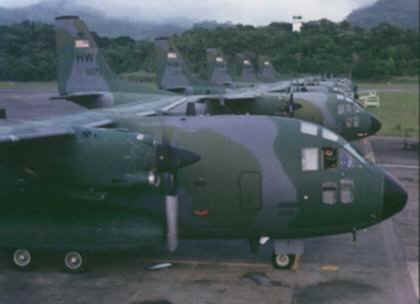
 Changing and
expanding military missions
--
including
training Latin American and Caribbean military personnel at the
U.S. military schools in Panama and via military mobile
training teams in country; promoting security and
stability in the region, regional cooperative security, professionalism in the
militaries in the region, and national assistance, humanitarian
and civic assistance, and disaster relief operations;
counterdrug assistance to U.S. Government agencies and host
nations -- primarily through detecting and monitoring drug
trafficking operations throughout the region; and assisting
in the development of modern militaries within friendly nations
in the region -- all in keeping with U.S. national interests
vis-a-vis Latin America and the Caribbean. One of the last
major missions assigned to the U.S. military in Panama was
initiating on October 1, 1979 (coinciding with the entry into
force of the Panama Canal Treaty of 1977) and carrying out the
unique 20-year Panama Canal Implementation Plan for phased
drawdown of U.S. Forces, transfer of all U.S. military property
to the Panamanian government, and withdrawal of the U.S.
military presence from Panama by December 31, 1999. During
the same period, the Panama Canal Commission worked closely with
its Panamanian counterparts and Canal workforce for the transfer
operation and ownership of the Panama Canal to Panama on the
same date.
Changing and
expanding military missions
--
including
training Latin American and Caribbean military personnel at the
U.S. military schools in Panama and via military mobile
training teams in country; promoting security and
stability in the region, regional cooperative security, professionalism in the
militaries in the region, and national assistance, humanitarian
and civic assistance, and disaster relief operations;
counterdrug assistance to U.S. Government agencies and host
nations -- primarily through detecting and monitoring drug
trafficking operations throughout the region; and assisting
in the development of modern militaries within friendly nations
in the region -- all in keeping with U.S. national interests
vis-a-vis Latin America and the Caribbean. One of the last
major missions assigned to the U.S. military in Panama was
initiating on October 1, 1979 (coinciding with the entry into
force of the Panama Canal Treaty of 1977) and carrying out the
unique 20-year Panama Canal Implementation Plan for phased
drawdown of U.S. Forces, transfer of all U.S. military property
to the Panamanian government, and withdrawal of the U.S.
military presence from Panama by December 31, 1999. During
the same period, the Panama Canal Commission worked closely with
its Panamanian counterparts and Canal workforce for the transfer
operation and ownership of the Panama Canal to Panama on the
same date.
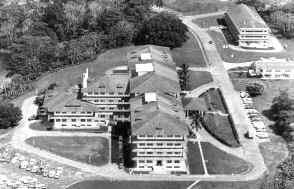


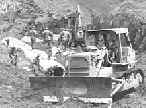
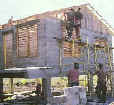
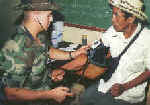

 History of
the military bases the United States maintained in
Panama
and the new uses of those bases
since their transfer to Panama. While much has been written about the Panama
Canal itself, very little has been written about the U.S. military
installations and properties constructed to support the U.S.
military mission of defending the Canal and U.S. national
interests. Therefore, part of this
site is devoted to documenting those installations (before history
here is rewritten or forgotten). The majority of those bases
are of historical and architectural significance and represent a
unique era in the social history of both the United States and
Panama.
History of
the military bases the United States maintained in
Panama
and the new uses of those bases
since their transfer to Panama. While much has been written about the Panama
Canal itself, very little has been written about the U.S. military
installations and properties constructed to support the U.S.
military mission of defending the Canal and U.S. national
interests. Therefore, part of this
site is devoted to documenting those installations (before history
here is rewritten or forgotten). The majority of those bases
are of historical and architectural significance and represent a
unique era in the social history of both the United States and
Panama.
| QUARRY
HEIGHTS |
FT.
AMADOR |
FT.
AMADOR |
FT.
CLAYTON |
HOWARD
AIR |
RODMAN
NAVAL |
 |
 |
 |
 |
 |
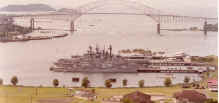 |
|
Unified
Command HQ |
Army |
Navy |
Army HQ |
FORCE
BASE |
STATION |
|
FT.
KOBBE |
MARINE |
FT.
GULICK |
FT.
SHERMAN |
FT.
DAVIS |
 |
 |
 |
 |
 |
|
Army |
BARRACKS |
Espinar |
Army |
Army |
 How the
95-year
presence ended through fulfillment of
the 20-year phase-out of U.S. military forces and transfer of all the
military bases and the Panama Canal to Panama by December 31 1999, as
mandated by the Panama Canal of 1977.
How the
95-year
presence ended through fulfillment of
the 20-year phase-out of U.S. military forces and transfer of all the
military bases and the Panama Canal to Panama by December 31 1999, as
mandated by the Panama Canal of 1977.

CHANGES AND
LOOKING AHEAD -- since U.S. presence in Panama ended December 31,
1999
 The former military bases have been converted to civilian uses
-- some completely, other
partially so far (as of December 2006), and not without some controversies
and problems along the way. Organizing, planning, managing,
and disposing of all U.S. military properties transferred to Panama from
October 1979 through 1999 -- about 5,200 buildings and other
facilities on about 95,300 acres within the former Canal Zone (known
since 1979 as the Panama Canal Area), including 12 major military
installations or bases -- has been a major challenge for the Panamanian
Government. The undertaking was tremendous, unprecedented, and
challenging for the Interoceanic Region Authority (Autoridad de la
Region Interoceanica or ARI), the agency created by Panamanian law
in 1993 charged with that mission. The principal challenge for
Panama -- with an $8 billion economy -- has been to absorb and maintain
over $4 billion dollars worth of military properties, promote them to
potential local and foreign investors, and convert them to other uses in
a timely and efficient manner to maximize their value for the benefit of
the people of Panama. Much to tell in this
area of what might be described as probably one of the largest real-estate transfers in
history and a unique experience for both Panama and the
United States.
The former military bases have been converted to civilian uses
-- some completely, other
partially so far (as of December 2006), and not without some controversies
and problems along the way. Organizing, planning, managing,
and disposing of all U.S. military properties transferred to Panama from
October 1979 through 1999 -- about 5,200 buildings and other
facilities on about 95,300 acres within the former Canal Zone (known
since 1979 as the Panama Canal Area), including 12 major military
installations or bases -- has been a major challenge for the Panamanian
Government. The undertaking was tremendous, unprecedented, and
challenging for the Interoceanic Region Authority (Autoridad de la
Region Interoceanica or ARI), the agency created by Panamanian law
in 1993 charged with that mission. The principal challenge for
Panama -- with an $8 billion economy -- has been to absorb and maintain
over $4 billion dollars worth of military properties, promote them to
potential local and foreign investors, and convert them to other uses in
a timely and efficient manner to maximize their value for the benefit of
the people of Panama. Much to tell in this
area of what might be described as probably one of the largest real-estate transfers in
history and a unique experience for both Panama and the
United States.
|
CLAYTON |
ALBROOK |
GULICK
/ ESPINAR |
AMADOR |
Flamenco
Island |
 |
 |
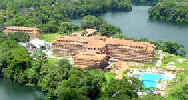 |
 |
 |
| City
of Knowledge |
Airport,
Albrook Mall, Transport Center
|
Melia
Hotel Pan Canal |
Tourism
Complex |
Flamenco
Mall |
 The Panama Canal continues
to be run quite well by Panama's Autoridad del Canal de Panama
(ACP) (Panama Canal Authority, an autonomous agency of the Panamanian
Government), which is continuing with Canal
modernization and improvement projects (many started shortly
before the Canal's transfer to Panama December 31, 1999) and has recently conducted
studies on possible canal widening and canal expansion projects,
principally the ambitious Third Set of Locks construction
project which was unveiled April 24,
2006, to accommodate post-Panamax ships through the canal. (The
Panamanian public approved that proposal in a referendum October 22,
2006, about 78 percent for and 22 percent against it. ACP projected the construction project to cost $5.25 billion and
to be completed in 2014.) Start of work on that canal expansion
project was inaugurated September 3, 2007.
The Panama Canal continues
to be run quite well by Panama's Autoridad del Canal de Panama
(ACP) (Panama Canal Authority, an autonomous agency of the Panamanian
Government), which is continuing with Canal
modernization and improvement projects (many started shortly
before the Canal's transfer to Panama December 31, 1999) and has recently conducted
studies on possible canal widening and canal expansion projects,
principally the ambitious Third Set of Locks construction
project which was unveiled April 24,
2006, to accommodate post-Panamax ships through the canal. (The
Panamanian public approved that proposal in a referendum October 22,
2006, about 78 percent for and 22 percent against it. ACP projected the construction project to cost $5.25 billion and
to be completed in 2014.) Start of work on that canal expansion
project was inaugurated September 3, 2007.
In the first
year since the Canal's transfer, ACP shifted successfully the Canal from being a public utility
a process (that began in 1997 while the Canal was still under
U.S. control) to a full business enterprise committed to
market-oriented, demand-driven business principles. In the first
five years (ending 2004) under Panamanian ownership, the Panama Canal
organization achieved several significant accomplishments including notable increases in tonnage
(particularly container ships) transiting the Canal, decrease in
the total time for ships to transit the Canal, decrease in ship
accidents while in transit, among others. In the Canal's first six
years under Panamanian control (beginning January 1, 2000 to the end of
September 2005), the Panama Canal Authority's operations generated a total of
$2 billion 277 million in revenues to the Panamanian government treasury
-- more than the total $1 billion
877.9 million the Panamanian government had received in annual payments
from the United States government during the 86 years the Canal was under American
control.


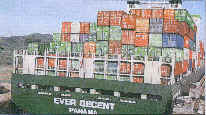


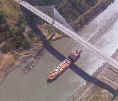
 A totally overhauled Panama
Railroad (48 miles long originally constructed in 1850-1955 by a U.S.
consortium as the world’s first transcontinental railway ) has become
-- since having been completely rebuilt in 2000-2001 by a United States
joint-venture enterprise 21 years after the United States transferred it
to Panamanian ownership -- the other prime mover of containers
between Panama's Pacific and Atlantic ports.
A totally overhauled Panama
Railroad (48 miles long originally constructed in 1850-1955 by a U.S.
consortium as the world’s first transcontinental railway ) has become
-- since having been completely rebuilt in 2000-2001 by a United States
joint-venture enterprise 21 years after the United States transferred it
to Panamanian ownership -- the other prime mover of containers
between Panama's Pacific and Atlantic ports.
 Tourism
since 2000 also has taken on a new
meaning, impetus and resources in Panama, including on some of the
former military properties, most notably Amador and the nearby
islands (Flamenco, Perico, Naos, and Culebra) and Kobbe on the Pacific side of the
isthmus and eco-tourist facilities at Sherman on the Atlantic side
and, in between, Canopy Tower near Gamboa.
Tourism
since 2000 also has taken on a new
meaning, impetus and resources in Panama, including on some of the
former military properties, most notably Amador and the nearby
islands (Flamenco, Perico, Naos, and Culebra) and Kobbe on the Pacific side of the
isthmus and eco-tourist facilities at Sherman on the Atlantic side
and, in between, Canopy Tower near Gamboa.


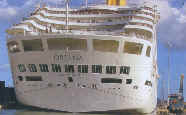



 Panama has become a main center of
container transportation in Latin America
since the 1996
privatization and modernization of the Balboa and Cristobal ports (at
both ends of the Canal and originally part of the Panama Canal
organization until late 1979), the complete overhaul of the interoceanic Panama Railroad
for moving containers across the isthmus, and creation of two
other new and modern container ports on the Atlantic side.
Today more than two million containers annually pass
through the Panama Canal and these ports, up from some 150,000 containers per
year in the decade of the 1990s.
Panama has become a main center of
container transportation in Latin America
since the 1996
privatization and modernization of the Balboa and Cristobal ports (at
both ends of the Canal and originally part of the Panama Canal
organization until late 1979), the complete overhaul of the interoceanic Panama Railroad
for moving containers across the isthmus, and creation of two
other new and modern container ports on the Atlantic side.
Today more than two million containers annually pass
through the Panama Canal and these ports, up from some 150,000 containers per
year in the decade of the 1990s.
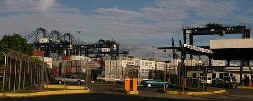


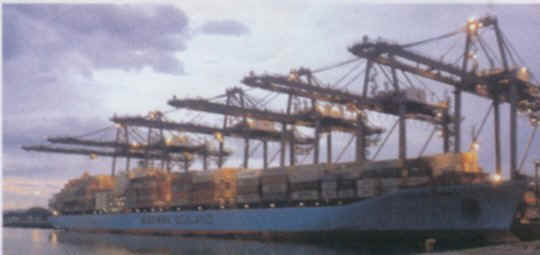
 A new relationship is emerging between the two countries
(after termination of the special relationship Panama enjoyed with
the United States during the 20th Century principally by virtue of
the Panama Canal and the U.S. military presence).
A new relationship is emerging between the two countries
(after termination of the special relationship Panama enjoyed with
the United States during the 20th Century principally by virtue of
the Panama Canal and the U.S. military presence).
AND
BEYOND: Other
subject areas to be developed at Other
Topics.